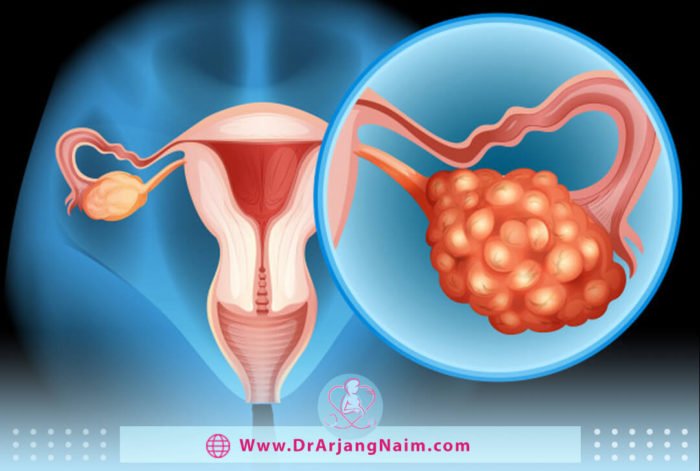Ovarian cancer is a type of cancer that starts in the ovaries. The female reproductive system consists of two ovaries on one side of the uterus. Each ovary is the size of an almond, which produces eggs and the hormones estrogen and progesterone.
Cancer that develops in the ovaries is often undetectable until it has spread to the pelvis and abdomen. If cancer that develops in the ovaries is not diagnosed early, treatment is difficult, but in the early stages, when the disease is limited to the ovaries, treatment is likely to be successful. Chemotherapy and Surgery are generally used to treat ovarian cancer.
Ovarian cancer is when abnormal ovarian cells begin to multiply and form a tumor out of control. If left untreated, cancer can spread to other parts of the body. Cancer often has warning signs, but the initial symptoms are vague and go away quickly. 20% of ovarian cancers are diagnosed in the early stages.
Symptoms
Early signs of ovarian cancer are difficult to diagnose because they are similar to other common diseases and are unstable. Early symptoms include the following:
- Abdominal bloating, pressure, and pain
- Abnormal fullness after eating
- Difficulty eating
- An increased urge to urinate
- An increase in urination
Cancer that develops in the ovaries can also cause other symptoms, such as:
- Fatigue
- Indigestion
- Menstrual irregularities
- Painful intercourse
- Heartburn
- Constipation
- Back pain
- Dermatomyositis
These symptoms can be present for any reason, not necessarily due to ovarian cancer. These types of signs are often temporary and, in most cases, respond to simple treatments. Symptoms will continue if they are due to ovarian cancer. Symptoms usually get worse as the tumor grows. At this time, cancer has usually spread beyond the ovaries.
Types of ovarian cancer
More than 30 different types of ovarian cancer are classified according to the cell from which they originate. Cancer tumors start from three common cell types:
- Surface epithelium
- Germ cells
- Stromal cells
Surface epithelium
Epithelial ovarian tumors arise from cells lining the ovary’s outer surface. Most epithelial ovarian tumors are benign. Several types of benign epithelial tumors include Serous adenomas, Mucosal adenomas, and Brenner tumors. Cancer epithelial tumors are carcinomas, meaning they start in the tissue that covers the ovaries. This type accounts for 85 to 90% of all ovarian cancers. Unfortunately, approximately 70% of women with ovarian epithelial cancer are not diagnosed until the disease progresses.
There are some ovarian epithelial tumors whose appearance under a microscope does not indicate that they are cancerous. These are called borderline tumors or tumors with a low potential for malignancy.
Germ cell tumors
Ovarian germ cell tumors arise from egg-producing cells. Most germ cell tumors are benign, although some are cancerous and may be life-threatening. Germ cell malignancy often occurs in teenagers and women in their twenties. Today, 90% of patients with ovarian germ cell malignancy can be improved and their fertility maintained.
Stromal tumors
Ovarian stromal tumors are a rare group that arises from connective tissue cells holding the ovary together and producing the female hormones estrogen and progesterone. The most common types are granulosa-theca tumors and Sertoli-Leydig cell tumors.
Stages
Staging is a way to describe the extent of cancer spread and show how far it has progressed. Knowing what stage the cancer is at helps doctors set up a treatment plan and give the patient an idea of what to expect. Diagnosis of ovarian cancer is based on physical examination and other tests that include:
- The size of the tumor
- To what extent does the tumor invade the tissues inside and around the ovary?
- The cancer spreads around the body (metastasis)
- Cancer is generally divided into four stages
Stage one
The first stage of cancer includes the following:
- IA: Cancer is found inside a single ovary.
- IB: Cancer is found inside both ovaries.
- IC: The tumor is inside one or both ovaries, and one of the following is true:
1. The outer capsule broke during surgery
2. The capsule burst before surgery
3. There are cancer cells on the outside of an ovary
4. Cancer cells are found in fluid washings from the abdomen
Stage two
In stage two, the cancer is in one or both ovaries and has spread to other parts of the pelvis. This step includes:
- 2A: Cancer has spread to the uterus or fallopian tubes.
- 2B: Cancer has spread to other pelvic tissues.
Stage three
In stage 3, the cancer is found in one or both ovaries and in the abdomen’s lining or has spread to the stomach’s lymph nodes. This step includes:
- 3A: Cancer is found in other pelvic organs and the lymph nodes inside the abdominal cavity or the abdomen’s lining.
- 3B: It is when cancer has spread to the organs around the pelvis. Cancer cells may be found on the outside of the liver or spleen or in the lymph nodes.
- 3C: More deposits of cancer cells are found outside the spleen or liver or have spread to the lymph nodes.
Stage four
The fourth stage is the most advanced stage of cancer that develops in the ovaries. This means that cancer has spread to areas or organs around the body. This step includes:
- 4A: Cancer cells are present in the fluid around the lungs.
- 4B: Cancer cells have spread to the inside of the spleen or liver, distant lymph nodes, or other distant organs such as the skin, lungs, or brain.
Causes
Cancer that develops in the ovaries occurs when cells in this area of the body divide and multiply uncontrollably. Researchers have many theories about this type of cancer, but no one knows exactly what causes ovarian cancer. Scientists have not been able to find a chemical in the environment and diets that are specifically linked to ovarian cancer. But in general, some reasons increase the risk of infection.
Genetics
About 20 to 25 percent of women with this type of cancer have an inherited predisposition to the disease. The most critical risk factor for ovarian cancer is an inherited genetic mutation in breast cancer gene 1 (BRCA1) or breast cancer gene 2 (BRCA2). These genes are responsible for about 10 to 15 percent of all ovarian cancers.
Because these genes are linked to breast and ovarian cancer, women with breast cancer have an increased risk of developing cancer in the ovaries.
Another known genetic link to ovarian cancer is Lynch Syndrome or an inherited syndrome called hereditary non-polyposis colon cancer (HNPCC). While HNPCC carries the highest risk of colon cancer, women with HNPCC are about 12 percent more likely to develop ovarian cancer and 40-60 percent more likely to develop uterine cancer.
Family history
People with two or more close relatives with cancer that develops in the ovaries have an increased risk of developing the disease. While family history covers only a limited number of cases, heredity is a risk factor for ovarian cancer. Family history should be considered. However, many women without a family history may still have a gene mutation associated with ovarian cancer risk.
All women with ovarian, primary peritoneal, or fallopian tube cancer should be referred for genetic counseling and genetic testing. A family history of any of the following cancers may indicate an increased risk:
- Breast cancer
- Colon cancer
- Uterine cancer
- Rectal cancer
Personal history of cancer or endometriosis
Women with breast cancer, uterus, colon, or rectum cancer are at higher risk for ovarian cancer. Having endometriosis increases the risk of clearing cancer cells and endometrioid ovaries two to three times.
Increasing age
All women, regardless of age, are at risk for ovarian cancer. However, the rate of it is higher in women aged 55-64. The average age of diagnosis for women is 63, which means that half of the women are less than 63 years old when diagnosed, and half are more than 63 years old.
Reproductive history and infertility
Research shows a relationship between the number of menstrual periods in a woman’s lifetime and the risk of ovarian cancer. Conditions that increase the risk in women include:
- Never gave birth
- The period started before age 12
- Started after age 50
- Never took birth control pills
- Experienced infertility
- First pregnancy after the age of 30
Hormone replacement therapy
Doctors may prescribe hormone replacement therapy to reduce the symptoms associated with menopause that are hormone replacement, and the body is adapted to lower estrogen levels. Hormone replacement therapy usually involves estrogen therapy alone for women who have had a hysterectomy or a combination of estrogen with progesterone or progestin for women who have not had a hysterectomy.
Women taking menopausal hormone therapy are at risk for ovarian cancer. Recent studies show that using a combination of estrogen and progestin for five years or more significantly increases the risk of cancer in women who have not had uterine surgery. Ten years or more of estrogen use increases the risk of ovarian cancer in women who have had uterine surgery.
Obesity
Various studies have found an association between obesity and ovarian cancer. Obese women between the ages of 50 and 71 who have not taken hormones after menopause are about 80 percent more likely to develop cancer in the ovaries.
Other potential risk factors include:
- Having high levels of androgens, or male hormones
- Dietary factors
- The use of talcum powder
- Smoking
- Polycystic ovary syndrome
Diagnosis

When a doctor diagnoses it early, it is much easier to treat cancer. However, it is not easy to detect. The ovaries are located deep in the abdominal cavity, so a person is unlikely to feel the tumor. No routine diagnostic screening for cancer is available. It is important to report unusual or persistent symptoms to your doctor. The doctor first examines the pelvis. The doctor may also perform the following tests:
- Transvaginal ultrasound (TVUS): Vaginal ultrasound is an imaging test that uses sound waves to detect the reproductive organs’ tumors, including the ovaries. However, TVUS cannot help your doctor determine if tumors are cancerous.
- Abdominal and pelvic CT scan: Computed tomography (CT) of the abdomen and pelvis is a diagnostic imaging test used to help diagnose diseases of the small intestine, colon, and other internal organs, often used to determine the cause of unexplained pain. CT scan is fast, painless, non-invasive, and accurate.
- Blood test: Blood tests are used to measure the level of cancer antigen 125 (CA-125). The CA-125 test is a biomarker used to assess the therapeutic response of cancer that develops in the ovaries and other cancers of the reproductive organ. However, menstruation, uterine fibroids, and uterine cancer can also affect the level of CA-125 in the blood.
- Biopsy: Sampling involves taking a small sample of ovarian tissue and analyzing the sample under a microscope.
Treatment
Treatment of cancer that develops in the ovaries depends on many factors, including:
- Type, stage, and grade of the cancer
- Individual’s age and overall health
- Accessibility and affordability of treatment
- Personal preferences
Surgery
The choice of surgical method will depend on the type of cancer and the extent of its spread. Surgical options include the removal of the uterus, the removal of one or both ovaries, and the removal of damaged lymph nodes.
Chemotherapy
The purpose of these drugs is to kill cancer cells. If a person takes chemotherapy drugs by mouth or by injection, it affects the whole body. Another option is intraperitoneal chemotherapy. In this case, a tube of the drug is delivered directly to the body affected by cancer. Chemotherapy can have many side effects, especially if it affects the whole body.
Targeted therapy
This method uses drugs that target specific vulnerabilities in cancer cells. It is usually used when cancer returns after the initial treatment or does not respond to other treatments. This method minimizes damage to healthy cells compared to conventional chemotherapy and reduces side effects. Examples include treatment with monoclonal antibodies and angiogenesis inhibitors.
Radiation therapy
This method uses X-rays to kill cancer cells. One way to do this is to inject radioactive fluid into the peritoneum.
Immunotherapy (biotherapy)
This type of treatment strengthens the body’s immune system’s ability to defend itself against cancer. Vaccine therapy involves injecting substances that find and kill the tumor. This may help people with advanced ovarian cancer.
Hormone therapy
This method may be added to the treatment program to prevent estrogen from reaching the cancer cells. Discontinuation of estrogen will reduce the growth of cancer cells.
Prevention

There is no safe way to prevent cancer from developing in the ovaries, but there may be ways to reduce the risk.
Taking birth control pills
Women should ask their doctor if taking birth control pills is right for them. Women taking birth control pills may reduce their risk of ovarian cancer. But contraception with these oral medications also has its risks.
Talk to a doctor about risk factors
A woman with a family history of breast and ovarian cancer should talk to her doctor about it. A doctor can determine if this means women have a risk of cancer. In some cases, the doctor may recommend a genetic counselor, and the risk of developing ovarian cancer increases if she has a genetic mutation. In this case, surgery may be performed to remove the ovaries to prevent cancer.
Statistics
While the ovaries may be just one organ, there are more than 30 types of ovarian cancer. They are classified according to the type of cell in which cancer begins and the stage of cancer. The most common type of cancer is epithelial tumors. More than 85% of cancer that develops in the ovaries first develops in cells that line outside the ovary.
Cancer that develops in the ovaries ranks fifth in cancer deaths among American women. It causes more deaths than any other cancer in the female reproductive system. One in 78 women will develop in their lifetime. Older women are more likely to develop cancer. The average age for diagnosing cancer that develops in the ovaries is 63 years. Only 15% of cases of cancer are diagnosed in the early stages. Fortunately, the American Cancer Society says the incidence of this type of cancer in women has dropped over the past two decades.
The bottom line
The female reproductive system consists of two reproductive glands called the ovaries. The ovaries on either side of the uterus are responsible for producing eggs and the female hormones estrogen and progesterone.
Ovarian cancer develops when abnormal cells in the ovary begin to overgrow. Cancer is often not diagnosed in the late stages until it has spread to the pelvis and abdomen. In the late stages, treatment is more difficult, while in the early stages, when the disease is limited to the ovaries, treatment is more likely to succeed. For this reason, it is very important to see a gynecologist in time if you notice any unusual symptoms.
Arjang Naim MD suggests the best treatment for the patient with an early diagnosis of ovarian cancer.
Additional questions
- What does metastasis mean?
The spread of cancer cells from where they first formed to another part of the body.
- What are the three main gene mutations?
There are three types of DNA Mutations:
- Base substitutions
- Deletions
- Insertions
- What are the ten early signs of colon cancer?
- Blood in stools
- Changes in stools
- Rectal bleeding
- Trouble passing stool
- Anemia
- Abdominal pain
- Weight loss
- Constipation
- Diarrhea
- Nausea and vomiting
- Can birth control cause ovarian cancer?
The use of oral contraceptive pills reduces the risk of ovarian cancer for women at average risk.
- What is the life expectancy for ovarian cancer?
For all types of ovarian cancer combined, about 3 in 4 (72.4%) women with ovarian cancer survive at least one year after diagnosis.
References
https://www.medicalnewstoday.com/articles/159675#outlook
https://www.healthline.com/health/ovarian-cancer#statistics
https://www.plannedparenthood.org/learn/cancer/ovarian-cancer/what-if-im-diagnosed-ovarian-cancer
https://www.ovarian.org/about-ovarian-cancer/what-is-ovarian-cancer/types-a-stages
https://www.webmd.com/ovarian-cancer/guide/stages-ovarian-cancer
https://www.mayoclinic.org/diseases-conditions/ovarian-cancer/diagnosis-treatment/drc-20375946
https://www.cancercenter.com/cancer-types/ovarian-cancer/diagnosis-and-detection




